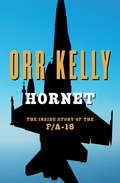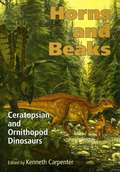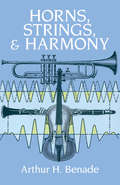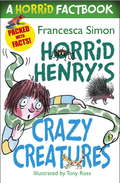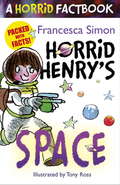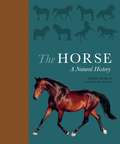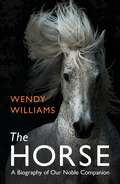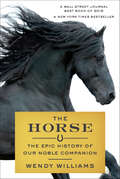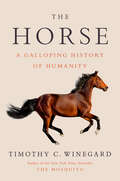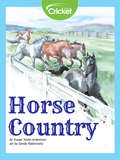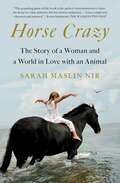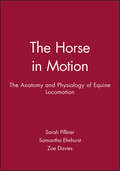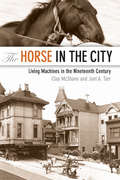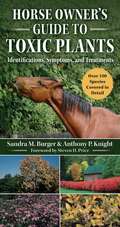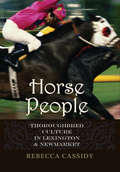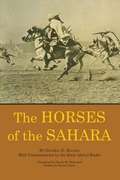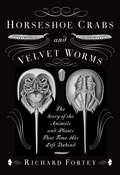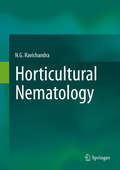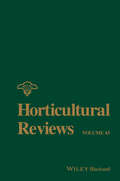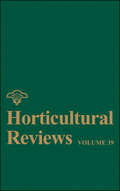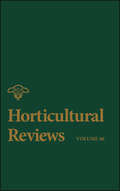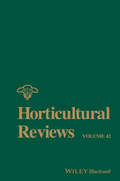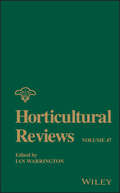- Table View
- List View
Hornet: The Inside Story of the F/A-18
by Orr KellyThe fascinating true story of the controversial development and deployment of the supersonic fighter jet that changed aerial warfare foreverThe McDonnell Douglas F/A-18 Hornet was born in 1978, a state-of-the-art supersonic fighter and attack aircraft with a top speed of Mach 1.8, more than one thousand miles per hour. It was versatile, fast, and reliable, and no war machine in the air could match it. The marines adopted it first, followed by the navy, impressed by its incomparable ability to engage in close aerial combat while at the same time efficiently delivering explosive payloads to designated enemy targets. It became the aircraft of choice for the US Navy&’s famous Blue Angels flight demonstration squadron in 1986 and served ably in combat from its first mission—America&’s launched air strike against Libya that same year—through 1991&’s Operation Desert Storm and well beyond. Yet the Hornet has always been shrouded in controversy, and while still in its planning stages, it sparked an unprecedented political battle that nearly doomed the miraculous machine before it could take flight.Orr Kelly, the acclaimed military author who has notably chronicled the remarkable histories of the US Navy SEALs and other branches of America&’s Special Forces, tells the fascinating true story of the F/A-18 Hornet—how it came to be, how it almost wasn&’t, and how it forever altered the way our nation&’s wars are fought.
Horns and Beaks: Ceratopsian and Ornithopod Dinosaurs
by Kenneth CarpenterHorns and Beaks completes Ken Carpenter's series on the major dinosaur types. As with his volumes on armored, carnivorous, and sauropodomorph dinosaurs, this book collects original and new information, reflecting the latest discoveries and research on these two groups of animals. The Ornithopods include Iguanodon, one of the first dinosaurs ever discovered and analyzed, and perhaps the most common and best-documented group, the hadrosaurs or "duckbilled dinosaurs." The Ceratopsians include Triceratops, known for its distinctive three-horned skull and protective collar.Contributors are Michael K. Brett-Surman, Kathleen Brill, Kenneth Carpenter, Benjamin S. Creisler, Tony DiCroce, Andrew A. Farke, Peter M. Galton, David Gilpin, Thomas M. Lehman, Nate L. Murphy, Christopher J. Ott, Gregory S. Paul, Xabier Pereda Suberbiola, Albert Prieto-Marquez, Bruce Rothschild, José Ignacio Ruiz-Omeñaca, Darren H. Tanke, Mark Thompson, David Trexler, and Jonathan R. Wagner.
Horns, Strings, and Harmony (Dover Books On Music: Acoustics)
by Arthur H. Benade"A fascinating excursion into an area too often ignored by the musical practitioner." — Music Library Association Notes.If you've ever wondered how a musical instrument produces the sound it does, this book explains the physics of musical instruments in an engaging and understandable way. Dr. Benade was a nuclear physicist, flutist, and science educator with a special ability to explain complex ideas in a simple, straightforward manner. In this book he brings that ability to bear in elucidating the ways in which music is formed by many different kinds of musical instruments.Dr. Benade first explores simple and complex vibrating systems and the ear's reception of sound. He then describes the fundamentals of the piano, violin, trumpet, bugle, trombone, oboe, clarinet, flute, saxophone, and many other instruments, demonstrating the sound-making capacities of each. For mechanically inclined readers who are interested in constructing basic instrumental models, Dr. Benade demonstrates how to build a working trumpet, flute, and clarinet.Enhanced with clear diagrams and easy scientific models, Horns, Strings, and Harmony is a book that will increase the musical enjoyment and understanding of all musicians, music lovers, and amateur scientists."The book is commended not only to the 'young person' who seeks to know some physics of musical instruments but also to those who would like to review in simple outline the basic physics of what happens within a musical instrument." — Journal of the Acoustical Society of America.
Horns, Tusks, and Flippers: The Evolution of Hoofed Mammals
by Donald R. Prothero Robert M. SchochSince the extinction of the dinosaurs, hoofed mammals have been the planet's dominant herbivores. Native to all continents except Australia and Antarctica, they include not only even-toed artiodactyls (pigs, hippos, camels, deer, antelopes, giraffes, sheep, goats, and cattle) and odd-toed perissodactyls (horses and rhinos), but also tethytheres (elephants and their aquatic relatives, manatees and seas cows) and cetaceans (whales and dolphins), which descended from hoofed land mammals. Recent paleontological and biological discoveries have deepened our understanding of their evolution and in some cases have made previous theories obsolete. <p><p>In Horns, Tusks, and Flippers, Donald R. Prothero and Robert M. Schoch present a compelling new evolutionary history of these remarkable creatures, combining the latest scientific evidence with the most current information about their ecology and behavior.
Horrid Henry's Crazy Creatures: A Horrid Factbook (Horrid Henry Ser.)
by Francesca SimonFrom multi-million-copy selling author, Francesca Simon, and David Walliams' illustrator, Tony Ross, comes the latest title in the successful Horrid Henry's Factbooks series. What's the only animal in the world to produce cube-shaped poo? What kind of lizard looks as though it has two heads? And what happens when a tarantula loses a leg?Bursting with foul facts and twisted trivia, this is the perfect guide to everything a Horrid Henry fan has ever wanted to know about animals. Gross out your family and amaze your friends with your nasty new knowledge!
Horrid Henry's Crazy Creatures: A Horrid Factbook (Horrid Henry #1)
by Francesca SimonFrom multi-million-copy selling author, Francesca Simon, and David Walliams' illustrator, Tony Ross, comes the latest title in the successful Horrid Henry's Factbooks series. What's the only animal in the world to produce cube-shaped poo? What kind of lizard looks as though it has two heads? And what happens when a tarantula loses a leg?Bursting with foul facts and twisted trivia, this is the perfect guide to everything a Horrid Henry fan has ever wanted to know about animals. Gross out your family and amaze your friends with your nasty new knowledge!
Horrid Henry's Space: A Horrid Factbook (Horrid Henry #1)
by Francesca SimonFrom multi-million-copy selling author Francesca Simon, and David Walliams' illustrator, Tony Ross, comes the intriguing tenth Horrid Henry's Factbook about all things outer space. What sound does the sun make? How long would it take to travel there in a car? And how do astronauts go to the toilet? Bursting with out-of-this-world facts and cosmic trivia, this is the perfect guide to everything a Horrid Henry fan has ever wanted to know about outer space, ideal for budding scientists and astronauts and Henry fanatics alike. Readers can surprise and awe their family and friends with amazing new knowledge!
The Horse: A Natural History
by Debbie Busby Professor Catrin RutlandA comprehensive, richly illustrated introduction to the fascinating natural history of the horse, from prehistory to the presentThere are countless books about keeping and riding horses. The Horse is different: it looks not only at the natural history of the horse in the context of its use by humans, but also at its own, independent story, describing the way horses live, think, and behave both alongside people and on their own. Beautifully designed and illustrated, The Horse provides an engaging and accessible introduction to these beloved animals.Beginning with evolution and development, The Horse tells how horses came into being more than fifty million years ago and were first domesticated more than five thousand years ago, eventually spreading across the globe. Chapters on Anatomy & Biology and Society & Behavior explain equine anatomy and how it has affected the lives and social structure of horses, and outline current scientific thinking on their behavior as individual and herd animals, including information on communication between horses. A chapter on Horses & People provides a thorough overview of the horse’s many important roles in human history and today, from pack animal to sporting champion. Finally, the book ends with an engrossing and visually stunning photographic gallery of some fifty popular breeds of horses and ponies with essential information about each.Filled with surprising facts and insights, this book will delight anyone who loves horses and wants to understand them better.Provides a comprehensive, richly illustrated introduction to the evolution, development, domestication, and behavior of the horse—from life cycle, breeding, coats and colors, and the senses to courtship, parenting, communication, emotions, and learningTells the full story of horses, from their earliest fossil ancestors to the modern-day EquusOffers a detailed survey of how horses and humans have interacted since horses were domesticated, including their use for work and war in the past and recreational and competitive riding todayFeatures infographics, diagrams, and more than 250 stunning color photographsIncludes a beautiful photographic directory to some 50 popular breeds
The Horse: A Biography of Our Noble Companion
by Wendy WilliamsHorses have been immensely helpful to mankind through history; we've used them for work, transport, and sport. They even played a key role in confirming and then refining Darwin's theory of evolution. But do they get anything out of this relationship with us? And what would have happened if we'd simply left them alone?Williams traces the history of the horse from its origins to the present day. She explores the horse-human relationship through history, taking us from Solutre, where thousands of horses were butchered, through to their domestic relationship with us which began 6,000 years ago. The Horse is a search for an answer to the question of what it's like to be a horse, ending with a look ahead to what the future holds for humans and equines.
The Horse: The Epic History of Our Noble Companion
by Wendy WilliamsThe New York Times bestseller: “Lifelong equestrian enthusiast Williams takes on the topic at full gallop . . . [a] lively, fascinating read.” —DiscoverA Best Book of 2015, The Wall Street JournalA New York Times Book Review Editors’ ChoiceJournalist and equestrienne Wendy Williams chronicles the 56-million-year journey of horses as she visits with experts around the world, exploring what our biological affinities and differences can tell us about the bond between horses and humans, and what our longtime companion might think and feel. Indeed, recent scientific breakthroughs regarding the social and cognitive capacities of the horse and its ability to adapt to changing ecosystems indicate that this animal is a major evolutionary triumph.Williams charts the course that leads to our modern Equus-from the protohorse to the Dutch Warmbloods, Thoroughbreds, and cow ponies of the twenty-first century. She observes magnificent ancient cave art in France and Spain that signals a deep respect and admiration for horses well before they were domesticated; visits the mountains of Wyoming with experts in equine behavior to understand the dynamics of free-roaming mustangs; witnesses the fluid gracefulness of the famous Lipizzans of Vienna; contemplates what life is like for the sure-footed, mustachioed Garrano horses who thrive on the rugged terrain of Galicia; meets a family devoted to rehabilitating abandoned mustangs on their New Hampshire farm; celebrates the Takhi horses of Mongolia; and more. She blends profound scientific insights with remarkable stories to create a unique biography of the horse as a sentient being with a fascinating past and a finely nuanced mind.
The Horse: A Galloping History of Humanity
by Timothy C. WinegardFrom New York Times bestselling author of The Mosquito, the incredible story of how the horse shaped human historyTimothy C. Winegard&’s The Horse is an epic history unlike any other. Its story begins more than 5,500 years ago on the windswept grasslands of the Eurasian Steppe; when one human tamed one horse, an unbreakable bond was forged and the future of humanity was instantly rewritten, placing the reins of destiny firmly in human hands.Since that pivotal day, the horse has carried the history of civilizations on its powerful back. For millennia it was the primary mode of transportation, an essential farming machine, a steadfast companion, and a formidable weapon of war. Possessing a unique combination of size, speed, strength, and stamina, the horse dominated every facet of human life and shaped the very scope of human ambition. And we still live among its galloping shadows.Horses revolutionized the way we hunted, traded, traveled, farmed, fought, worshipped, and interacted. They fundamentally reshaped the human genome and the world&’s linguistic map. They determined international borders, molded cultures, fueled economies, and built global superpowers. They decided the destinies of conquerors and empires. And they were vectors of lethal disease and contributed to lifesaving medical innovations. Horses even inspired architecture, invention, furniture, and fashion. From the thundering cavalry charges of Alexander the Great to the streets of New York during the Great Manure Crisis of 1894 and beyond, horses have shaped both the grand arc of history and our everyday lives.Driven by fascinating revelations and fast-paced storytelling, The Horse is a riveting narrative of this noble animal&’s unrivaled and enduring reign across human history. To know the horse is to understand the world.
Horse Country
by Susan Yoder AckermanKyle is afraid of horses, so the last thing he wants to do is go horseback riding with his Aunt Maggie. As he interacts with them and learns more about them, however, he begins to appreciate them. He learns that horses are not just pets—they can also be friends!
Horse Crazy: The Story of a Woman and a World in Love with an Animal
by Sarah Maslin NirONE OF USA TODAY'S &“20 SUMMER BOOKS YOU WON'T WANT TO MISS&” In the bestselling tradition of works by such authors as Susan Orlean and Mary Roach, a New York Times reporter and Pulitzer Prize finalist explores why so many people—including herself—are obsessed with horses.It may surprise you to learn that there are over seven million horses in America—even more than when they were the only means of transportation—and nearly two million horse owners. Acclaimed journalist and avid equestrian Sarah Maslin Nir is one of them; she began riding horses when she was just two years old and hasn&’t stopped since. Horse Crazy is a fascinating, funny, and moving love letter to these graceful animals and the people who—like her—are obsessed with them. It is also a coming-of-age story of Nir growing up an outsider within the world&’s most elite inner circles, and finding her true north in horses. Nir takes readers into the lesser-known corners of the riding world and profiles some of its most captivating figures. We meet Monty Roberts, the California trainer whose prowess earned him the nickname &“the man who listens to horses,&” and his pet deer; George and Ann Blair, who at their riding academy on a tiny island in Manhattan&’s Harlem River seek to resurrect the erased legacy of the African American cowboy; and Francesca Kelly, whose love for an Indian nobleman shaped her life&’s mission: to protect an endangered Indian breed of horse and bring them to America. Woven into these compelling character studies, Nir shares her own moving personal narrative. She details her father&’s harrowing tale of surviving the Holocaust, and describes an enchanted but deeply lonely upbringing in Manhattan, where horses became her family. She found them even in the middle of the city, in a stable disguised in an old townhouse and in Central Park, when she chased down truants as an auxiliary mounted patrol officer. And she speaks candidly of how horses have helped her overcome heartbreak and loss. Infused with heart and wit, and with each chapter named after a horse Nir has loved, Horse Crazy is an unforgettable blend of beautifully written memoir and first-rate reporting.
The Horse in Motion: The Anatomy and Physiology of Equine Locomotion
by Sarah Pilliner Samantha Elmhurst Zoe DaviesWe all want our horses to be able to perform to the best of their ability and we know that an effective training regime has many facets. The horse must be worked correctly, fed a balanced ration, mentally and physically healthy and well looked after. This book examines a further aspect of the horse's performance: it is designed to help all horse owners and riders to understand how a horse moves and how its anatomy helps, or hinders, the horse's athletic ability. First, the book uses sequences of photographs and detailed anatomical drawings to show the systems of support and movement at each phase of each of the horse's gaits. The walk, trot, canter, gallop and jump are all examined, and the effect of the rider on the horse evaluated so that the rider can take appropriate action to avoid hindering the horse. Tips are provided throughout on ways in which the horse's life can be made easier, such as saddle fitting, warming up and cooling down procedures.
The Horse in the City: Living Machines in the Nineteenth Century (Animals, History, Culture)
by Clay McShane Joel TarrHonorable mention, 2007 Lewis Mumford Prize, American Society of City and Regional PlanningThe nineteenth century was the golden age of the horse. In urban America, the indispensable horse provided the power for not only vehicles that moved freight, transported passengers, and fought fires but also equipment in breweries, mills, foundries, and machine shops.Clay McShane and Joel A. Tarr, prominent scholars of American urban life, here explore the critical role that the horse played in the growing nineteenth-century metropolis. Using such diverse sources as veterinary manuals, stable periodicals, teamster magazines, city newspapers, and agricultural yearbooks, they examine how the horses were housed and fed and how workers bred, trained, marketed, and employed their four-legged assets. Not omitting the problems of waste removal and corpse disposal, they touch on the municipal challenges of maintaining a safe and productive living environment for both horses and people and the rise of organizations like the American Society for the Prevention of Cruelty to Animals. In addition to providing an insightful account of life and work in nineteenth-century urban America, The Horse in the City brings us to a richer understanding of how the animal fared in this unnatural and presumably uncomfortable setting.
Horse Owner's Guide to Toxic Plants: Identifications, Symptoms, and Treatments
by Sandra McQuinnHorse Owner's Guide to Toxic Plants is a must-have, exclusive reference book for all horse owners, and the first of its kind on the subject of equines and plants. Keep this book in the medicine cabinet in the barn. Walk around the pastures with the book in hand, especially in late spring or early summer. Or pack it with on a trail ride. It just might save your horse's life.Horse Owner's Guide to Toxic Plants is organized according to types of plants—trees, bushes, shrubs, and vines, ferns and plants, weeds and wildflowers, and grasses and horsetails. Since visuals are very important for correct identification, clear color photographs are shown, including wherever possible a close-up photograph and line drawing to better identify each plant. Horsewoman Sandra McQuinn has researched and compiled information on more than 100 more common but toxic plants that grow in backyards, pastures, and on the range and trail. Also included is advice from a veterinarian on how to recognize the symptoms of poisonings in your horse and what steps you or your own veterinarian should take if you suspect your horse has eaten a toxic plant. Brimming with pertinent information and expert advice, Horse Owner's Guide to Toxic Plants is a must-have for all equine aficionados. No horse owner should be without it, including those who board their horses.
Horse People: Thoroughbred Culture in Lexington and Newmarket (Animals, History, Culture)
by Rebecca Louise CassidyThe world of Thoroughbred racing is glamorous, secretive, dangerous, and seductive—the sport of kings and the poor man's obsession. While the spectacle of racing stirs the imagination, it belies the ruthless business that lies beneath.This engaging original study demystifies this complex world by comparing centers of excellence in Britain and North America. Drawing from intensive field work in Suffolk's Newmarket and Kentucky's Lexington, Rebecca Cassidy gives us the inside track on all players in the industry—from the elite breeders and owners to the stable boys, racetrack workers, and veterinarians. She leads us through horse farms, breeding barns, and yearling sales; explains rigorous training regimens; and brings us trackside on race day.But the history of Thoroughbred racing culture is more than a collection of fascinating characters and exciting events. Cassidy's investigation reveals the factors—ethical, cultural, political, and economic—that have shaped the racing tradition.
The Horses of the Sahara
by General E. Daumas Sheila M. OhlendorfGeneral Daumas took part in the conquest of Algeria by France, so distinguishing himself that he was named Director of the Bureau of Algerian Affairs in the French Ministry of War. During the campaigns and the occupation that followed, he studied and attempted to understand the native peoples, with an objectivity and sympathy unusual among the colonialists of the period. His book provides fascinating sidelights on many aspects of Arab life, including customs, superstitions, religion, and family life.
Horseshoe Crabs and Velvet Worms
by Richard ForteyFrom one of the world's leading natural scientists and the acclaimed author of Trilobite!, Life: A Natural History of Four Billion Years of Life on Earth and Dry Storeroom No. 1 comes a fascinating chronicle of life's history told not through the fossil record but through the stories of organisms that have survived, almost unchanged, throughout time. Evolution, it seems, has not completely obliterated its tracks as more advanced organisms have evolved; the history of life on earth is far older--and odder--than many of us realize. Scattered across the globe, these remarkable plants and animals continue to mark seminal events in geological time. From a moonlit beach in Delaware, where the hardy horseshoe crab shuffles its way to a frenzy of mass mating just as it did 450 million years ago, to the dense rainforests of New Zealand, where the elusive, unprepossessing velvet worm has burrowed deep into rotting timber since before the breakup of the ancient supercontinent, to a stretch of Australian coastline with stromatolite formations that bear witness to the Precambrian dawn, the existence of these survivors offers us a tantalizing glimpse of pivotal points in evolutionary history. These are not "living fossils" but rather a handful of tenacious creatures of days long gone. Written in buoyant, sparkling prose, Horseshoe Crabs and Velvet Worms is a marvelously captivating exploration of the world's old-timers combining the very best of science writing with an explorer's sense of adventure and wonder.
Horticultural Nematology
by N. G. RavichandraThe major objective of this book is to highlight the significance of phytonematodes in horticulture. Detailed and latest information on major aspects of phytonematodes associated exclusively with horticultural crops, which is the need of the day, is lacking. Hence, the book has been written mainly with the objective of providing its readers, comprehensive information on the advanced aspects related to phytonematodes associated with horticultural crops. It also provides basic information on plant parasitic nematodes since it is required for a better understanding of advanced topics. Several popular topics, information on which is already available in plenty, have been avoided. Thus, book explicates both the essential fundamental and advanced aspects pertaining to nematodes associated with horticultural crops. The book is conveniently divided into 13 chapters, which cover latest information on the major fundamental and advanced aspects related to phytonematodes including the role of phytonematodes in horticultural industry, phylogenetic and evolutionary concepts in nematodes, major phytonematodes associated with horticultural crops and their diagnostic keys, symptoms caused by phytonematodes and disease diagnosis, nematode population threshold levels, crop loss assessment, nematode diseases of horticultural crops and their management, nematode disease complexes, genetics of nematode parasitism, important nematological techniques and nematodes of quarantine importance. An exclusive chapter on novel methods of nematode management has been included mainly to provide the information on the latest molecules and novel modes of managing nematodes attacking horticultural crops. Routine nematode management aspects, information on which is already available, have not been discussed; instead, this topic reflects the changing scenario of future nematode management. Hence, this book can serve as a friendly guide to meet the requirements of the students, teachers and researchers interested in these 'hidden enemies' of the grower, apart from the research and extension personnel working under Public organizations, officials of State departments of Horticulture, Forestry, field workers and all those concerned and working with plant parasitic nematodes. Appropriate diagrams, convincing tables and suitable graphs/illustrations have been furnished at right places. A complete bibliography has also been included.
Horticultural Reviews (Horticultural Reviews)
by Jules JanickHorticultural Reviews presents state-of-the-art reviews on topics in horticultural science and technology covering both basic and applied research. Topics covered include the horticulture of fruits, vegetables, nut crops, and ornamentals. These review articles, written by world authorities, bridge the gap between the specialized researcher and the broader community of horticultural scientists and teachers.
Horticultural Reviews (Horticultural Reviews #102)
by Jules JanickHorticultural Reviews presents state-of-the-art reviews on topics in horticultural science and technology covering both basic and applied research. Topics covered include the horticulture of fruits, vegetables, nut crops, and ornamentals. These review articles, written by world authorities, bridge the gap between the specialized researcher and the broader community of horticultural scientists and teachers.
Horticultural Reviews (Horticultural Reviews #104)
by Jules JanickHorticultural Reviews presents state-of-the-art reviews on topics in horticultural science and technology covering both basic and applied research. Topics covered include the horticulture of fruits, vegetables, nut crops, and ornamentals. These review articles, written by world authorities, bridge the gap between the specialized researcher and the broader community of horticultural scientists and teachers.
Horticultural Reviews
by Jules JanickHorticultural Reviews presents state-of-the-art reviews on topics in horticultural science and technology covering both basic and applied research. Topics covered include the horticulture of fruits, vegetables, nut crops, and ornamentals. These review articles, written by world authorities, bridge the gap between the specialized researcher and the broader community of horticultural scientists and teachers
Horticultural Reviews
by Ian WarringtonContents Contributors ix Dedication: Theodore DeJong xi 1. Molecular Physiology of Fruit Growth in Apple 1 2. Mechanosensing of Plants 43 3. Microgreens: Definitions, Product Types, and Production Practices 85 4. The Durian: Botany, Horticulture, and Utilization 125 5. The genus Cupressus L.: Mythology to Biotechnology with Emphasis on Mediterranean Cypress (Cupressus sempervirens L.) 213 6. Taxonomy and Botany of the Caricaceae 289 7. Entomopathogens: Potential to Control Thrips in Avocado, with Special Reference to Beauveria bassiana 325
